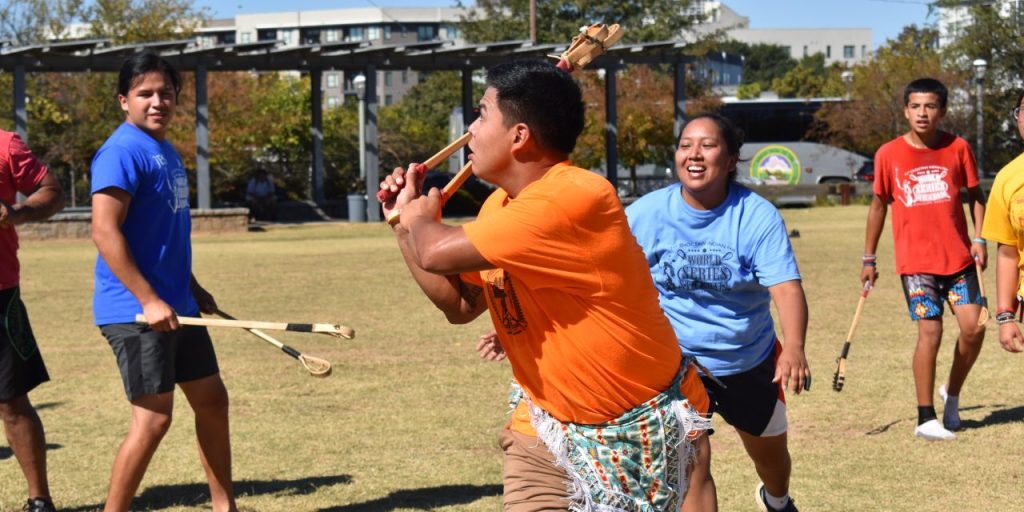Indigenous North American Stickball: A Rich Tradition and Sporting Legacy

Introduction
Deep within the heart of North America, there exists a tradition that predates modern sports and transcends generations—a tradition that speaks to the rich tapestry of Indigenous cultures. This cherished tradition, known as Indigenous North American Stickball, is not just a game; it is a symbol of unity, heritage, and resilience.
As we delve into the world of Indigenous North American Stickball, we uncover a fascinating history that has endured for centuries. This sport, deeply rooted in Native American culture, represents more than just athletic competition. It symbolizes the spiritual connection between the players and their ancestors, fostering a profound sense of community and identity.
In this blog post, we will journey through the history, significance, and gameplay of Indigenous North American Stickball, immersing ourselves in the tapestry of cultures that have kept this tradition alive. We’ll explore the unique equipment, rules, and rituals that make this sport a captivating blend of athleticism and spirituality.
But before we delve into the specifics, let’s first gain an appreciation for the cultural diversity and depth that underpins this extraordinary sport. Indigenous North American Stickball is more than just a game; it’s a window into the soul of Indigenous peoples. Join us as we embark on this illuminating exploration, uncovering the intricate layers of a tradition that continues to thrive in the modern world.
The Origins of Indigenous North American Stickball:
Indigenous North American Stickball has a long and storied history, with its roots stretching deep into the annals of time. This traditional sport, dating back centuries, has been played by various Native American tribes across the continent. Its origins are shrouded in myth and legend, making it a fascinating study of cultural heritage. Each tribe has its unique interpretation of the game, yet they all share common threads, uniting them in the celebration of their Indigenous identity through this beloved pastime.
Stickball: A Spiritual Connection to Ancestral Roots:
Beyond its status as a mere sport, Indigenous North American Stickball serves as a profound spiritual connection to the ancestors. For Indigenous communities, this game is a sacred ritual that transcends the physical realm. The act of playing stickball is an opportunity to connect with the spirits of their forebears, a means of honoring their heritage and preserving their traditions. The sticks, the balls, the songs, and the dances all hold deep spiritual significance, creating a profound link to the past.
The Significance of Stickball in Indigenous Communities:
Within Indigenous communities, stickball is more than just a recreational activity—it’s a cornerstone of their cultural identity. The sport plays a pivotal role in fostering unity, cooperation, and resilience among tribal members. It provides a platform for communal bonding and a source of pride, reminding individuals of their shared history and shared destiny. Stickball tournaments and gatherings become a celebration of Indigenous culture, attracting participants and spectators from far and wide.
Traditional Stickball: A Sport with a Sacred Purpose:
Traditional stickball games are not about winning or losing; they are about embracing the sacred purpose behind the sport. These games often feature unique customs, such as the “going to water” ceremony, which involves players immersing themselves in water as a form of purification and preparation for the game. The spiritual essence of stickball ensures that every match is an opportunity for participants to connect with their ancestors and celebrate their Indigenous heritage.
Stickball Equipment: Sticks, Balls, and More:
The equipment used in Indigenous North American Stickball is deeply rooted in tradition. Sticks, often made from hickory, feature distinct designs and shapes that vary among tribes. The ball, typically made from deerskin or a similar material, has a unique texture and weight. Beyond these basic elements, additional ceremonial items, such as rattles and drums, accompany the game to infuse it with a deep cultural significance. The crafting and decoration of these items reflect the artistry and craftsmanship of the tribe.
Rules of Play: How Stickball Games Unfold:
Stickball games have a unique set of rules and protocols that govern the action on the field. Typically played on a rectangular or square field, the objective is to score points by propelling the ball into the opposing team’s goal. The rules vary slightly from tribe to tribe, but they all emphasize skill, strategy, and teamwork. The games can be intense, often lasting for hours, and they showcase the athleticism and determination of the players. Stickball games are not only about winning but also about exhibiting honor, respect, and good sportsmanship.
Variations of Indigenous Stickball Games:
While the core principles of Indigenous North American Stickball remain consistent across tribes, there are fascinating variations that make each game unique. Some tribes play with large teams, while others have smaller squads. Variations in field size and terrain, as well as the presence of ceremonial elements, distinguish one tribe’s version of the game from another. These variations are a testament to the adaptability of the sport and its ability to evolve while maintaining its cultural essence.
Stickball Rituals and Ceremonies:
Stickball is not just a game; it’s a sacred ritual deeply intertwined with Indigenous ceremonies. Before a match, players often engage in pre-game rituals and ceremonies that honor their ancestors, seek protection, and invoke the spirits. Ceremonial songs, dances, and the blessing of the equipment are integral parts of these pre-game rituals. This spiritual preparation adds a profound layer of meaning to the game, making it more than a simple athletic competition.
Indigenous North American Stickball: A Test of Skill and Agility:
Stickball is a demanding sport that requires a combination of physical prowess, agility, and strategy. Players must possess excellent hand-eye coordination, speed, and endurance. The fast-paced nature of the game, combined with the unique equipment, challenges participants to exhibit exceptional skill. Stickball is not only a test of athleticism but also a showcase of mental acuity and teamwork. It’s a sport that demands both physical and intellectual engagement, making it a truly dynamic and exciting tradition.
The Role of Women in Stickball Traditions:
In many Indigenous communities, the role of women in Stickball traditions is a vital and often underappreciated aspect. While it’s more common for men to play the game, women contribute significantly to its cultural significance. They may serve as spectators, cheerleaders, or even as keepers of the sacred knowledge and rituals associated with the game. Some tribes also have women’s stickball games, offering a unique perspective on the sport and its cultural importance.
Stickball Legends and Stories: Tales of Triumph and Defeat:
Stickball legends and stories are woven into the fabric of Indigenous communities. These tales are not just about the games themselves but the triumphs and defeats of legendary players. These narratives serve as a source of inspiration, teaching valuable life lessons about resilience, determination, and the importance of cultural heritage. Through the retelling of these stories, the spirit of Indigenous North American Stickball continues to thrive and inspire future generations.
Stickball and Tribal Identity: A Unifying Force:
Indigenous North American Stickball serves as a powerful unifying force within tribes. It is a symbol of tribal identity, a source of pride, and a means of fostering a sense of belonging. When tribes gather to play or watch stickball, they reinforce their unique cultural identities while also promoting a broader Indigenous solidarity. This shared cultural touchstone transcends differences, uniting Indigenous people in their celebration of heritage and tradition.
The Revival of Stickball: Preserving Cultural Heritage:
In recent years, there has been a resurgence in the popularity of Indigenous North American Stickball. This revival is not only about celebrating the sport but also about preserving cultural heritage and passing it on to younger generations. Stickball tournaments, workshops, and educational initiatives have played a pivotal role in keeping the tradition alive. The revival is a testament to the resilience of Indigenous communities and their determination to ensure that their cultural treasures continue to shine.
Stickball in Modern Times: A Changing Landscape:
The landscape of Indigenous North American Stickball is evolving to adapt to the demands of modern times. While the core elements of the sport remain deeply rooted in tradition, there are modern influences that have shaped its development. From changes in equipment to variations in the rules, stickball continues to be a dynamic tradition that finds its place in the contemporary world while preserving its cultural significance.
Stickball and Medicine Men: Healing Through Sport:
For many Indigenous communities, the role of medicine men is essential in the context of stickball. These spiritual leaders not only bless the games but also offer healing ceremonies to players who may have sustained injuries during play. Stickball serves as a means of healing not just physically, but spiritually and emotionally, and the guidance of medicine men plays a vital role in this aspect of the sport.
**Stickball
Tournaments: Celebrating Competence and Sportsmanship:**
Stickball tournaments are not merely athletic events; they are celebrations of competence and sportsmanship. Teams from various tribes come together to showcase their skills, compete, and honor their heritage. These tournaments serve as a platform for the exchange of cultural knowledge, forging connections, and celebrating the athleticism and camaraderie that make Indigenous North American Stickball a unique sporting tradition.
Stickball and Seasonal Celebrations:
Stickball often takes center stage in seasonal celebrations among Indigenous communities. These celebrations are deeply rooted in cultural significance, and stickball games serve as a focal point, bringing communities together in the spirit of unity and festivity. These seasonal gatherings offer a vibrant blend of sport, spirituality, and cultural celebration.
The Art of Stickball: Crafts and Designs:
The artistry associated with Indigenous North American Stickball extends beyond the field of play. The creation of stickball equipment, including the crafting of sticks and the design of balls, is an art form in itself. These items are often adorned with intricate designs, reflecting the unique cultural aesthetics of each tribe. The art of stickball is not confined to the gameplay; it is an expression of creativity and heritage that transcends the boundaries of the game.
Indigenous North American Stickball Songs and Music:
Music is an integral part of stickball traditions, setting the tone for the games and infusing them with a unique rhythm and energy. Stickball songs, often accompanied by drums and other traditional instruments, serve as a source of motivation and inspiration for players. These songs tell stories, invoke spirits, and create a powerful atmosphere that elevates the significance of the game.
Stickball and Community Bonding:
Stickball has an unparalleled ability to foster community bonding within Indigenous societies. The sport brings people together, whether they are players, spectators, or supporters, creating a sense of togetherness that extends beyond the field. The bonds formed through stickball are a testament to the enduring power of culture and tradition in Indigenous communities.
Stickball and Leadership: Chiefs and Captains:
Leadership is a crucial element of Indigenous North American Stickball. Chiefs and captains play a central role in organizing teams, making strategic decisions, and upholding the traditions of the game. They are responsible for ensuring that the spirit of the sport is preserved and that it continues to serve as a unifying force within their communities.
Indigenous Stickball vs. Modern Sports:
Comparing Indigenous North American Stickball to modern sports provides a fascinating contrast between tradition and contemporary athletic activities. While modern sports often focus on competition and entertainment, stickball embraces a deeper cultural and spiritual significance. This comparison offers insights into the distinct values and priorities of Indigenous communities and their unique approach to sport.
The Impact of Colonization on Stickball Traditions:
The arrival of European colonizers had a profound impact on Indigenous North American Stickball traditions. Often suppressed and even banned by colonial authorities, these traditions endured through centuries of adversity. Understanding the resilience of stickball in the face of colonization sheds light on the enduring strength of Indigenous cultures.
Traditional Stickball vs. Lacrosse: A Comparison:
Comparing traditional stickball to lacrosse, a sport with some similarities, provides an opportunity to explore the nuances that differentiate the two. While both sports involve sticks and balls, they have distinct rules, equipment, and cultural significance. This comparison highlights the unique attributes of Indigenous North American Stickball.
Stickball and Language Preservation:
Language is a vital aspect of Indigenous culture, and stickball often plays a role in language preservation efforts. Many stickball terms and phrases are integral to the sport, making it a valuable tool for teaching and preserving Indigenous languages. This intersection between language and sport is a testament to the interconnectedness of cultural elements.
Stickball: Lessons in Teamwork and Cooperation:
Stickball is not merely a physical game; it’s a profound lesson in teamwork and cooperation. Players must work together seamlessly to achieve their goals, and this emphasis on collaboration extends beyond the field, teaching essential life skills and fostering a strong sense of community.
Stickball and Sportsmanship: Honoring Opponents:
Sportsmanship is a core value in Indigenous North American Stickball. The game emphasizes respect and honor for opponents, highlighting the importance of fair play, humility, and good character. Stickball teaches participants that winning or losing is secondary to the integrity and honor displayed on the field.
The Revival of Stickball in Indigenous Schools:
Indigenous schools play a pivotal role in reviving and preserving the tradition of stickball. They incorporate the sport into their curricula, ensuring that younger generations learn about its cultural significance. This revival within educational settings is a powerful tool for keeping the tradition alive and thriving.
Stickball Legends and Their Enduring Legacy:
Stickball has produced a pantheon of legends, whose stories continue to resonate with Indigenous communities. These legends are not just about athletic achievements but also about the cultural impact they had on their tribes. Their enduring legacy serves as a source of inspiration for young players and a testament to the enduring power of tradition.
Stickball Stories from Different Tribes:
Every tribe has its own unique stickball stories, passed down through generations. These stories vary in themes and characters, reflecting the diversity and individuality of each Indigenous culture. Exploring these narratives offers a rich tapestry of perspectives on the sport.
The Influence of Stickball on Art and Culture:
Stickball’s influence extends beyond the field into the realms of art and culture. The sport inspires various forms of artistic expression, from paintings and sculptures to storytelling and dance. These artistic interpretations of stickball provide a deeper understanding of the cultural significance and creative spirit of the sport.
Women’s Stickball: A Celebration of Strength:
Women’s stickball, a lesser-known but equally important facet of the tradition, is a celebration of female strength and resilience. These games offer a unique perspective on the sport and challenge traditional gender roles, showing the significant contributions of Indigenous women to the stickball tradition.
Stickball and Environmental Sustainability:
The traditional materials used in stickball, such as hickory sticks and deerskin balls, reflect a deep connection to the environment. Indigenous communities often practice sustainability by responsibly sourcing these materials and ensuring that their use respects the natural world. Stickball traditions promote a harmonious relationship between culture and the environment.
Stickball Celebrations: Powwows and Gatherings:
Stickball is a central feature of many Indigenous powwows and gatherings. These events serve as an opportunity for tribes to come together, showcase their stickball skills, and celebrate their heritage. Stickball celebrations are vibrant, joyful occasions that offer a rich cultural experience for both participants and spectators.
Stickball and Spirituality: A Sacred Connection:
The spiritual aspects of stickball cannot be overstated. It is a sacred connection to the spirit world and to the ancestors. The sport’s rituals, ceremonies, and symbolism all play a vital role in creating a profound connection to the spiritual realm. Stickball is a way for Indigenous communities to honor their beliefs and access the guidance and protection of their ancestors.
Stickball Across Generations: Passing Down the Tradition:
The passing down of stickball traditions from one generation to the next is a vital aspect of cultural preservation. Elders, parents, and community leaders play a crucial role in teaching young individuals the history, techniques, and significance of the sport. This intergenerational connection ensures that Indigenous North American Stickball remains a vibrant part .
Conclusion
In conclusion, Indigenous North American Stickball is a time-honored sporting tradition that transcends mere competition, reaching deep into the heart of Indigenous communities and their cultural identity. This extraordinary sport is steeped in spirituality, unity, and resilience, making it more than just a game—it’s a sacred connection to ancestral roots.
We’ve explored the origins of stickball, its deep-rooted significance, the cultural importance of its equipment and rituals, and the various dimensions that make it a unique and powerful tradition. From the role of women in stickball to the impact of colonization and the parallel with modern sports, we’ve uncovered the diverse and multifaceted nature of this timeless sport.
Stickball teaches lessons of teamwork, cooperation, and sportsmanship, promoting a sense of honor and respect not only for the game but also for opponents. Its enduring legacy continues to inspire and guide Indigenous communities, while its revival ensures that the tradition remains a vibrant part of their cultural heritage.
As stickball bridges the gap between the past and the present, it serves as a reminder of the resilience of Indigenous cultures and their determination to preserve their heritage in a rapidly changing world. The spiritual essence, artistic influence, and environmental sustainability associated with the sport add depth to its cultural significance.
In its role in seasonal celebrations, schools, and powwows, stickball has proven itself to be a unifying force that brings communities together, fostering a deep sense of togetherness. This tradition, intertwined with language preservation and the passing down of knowledge through generations, ensures its continued vibrancy and cultural importance.
Indigenous North American Stickball is more than just a sport; it’s a living testament to the enduring spirit of Indigenous communities and their commitment to preserving their heritage. It is a heritage that thrives through the power of tradition, the unity of communities, and the unwavering determination to ensure that their cultural treasures continue to shine for generations to come.
- What is the history of Indigenous North American Stickball? Learn about the rich history of Indigenous North American Stickball and how it has evolved over centuries within various tribal communities.
- What is the significance of stickball in Indigenous culture? Discover the cultural and spiritual significance of stickball in Indigenous communities and the role it plays in preserving their heritage.
- How does traditional stickball differ from modern sports? Explore the differences between traditional Indigenous stickball and modern sports, highlighting the unique values and priorities of Indigenous communities.
- Are there variations of stickball games among different tribes? Understand the fascinating variations of stickball among various Indigenous tribes, including differences in equipment, rules, and rituals.
- What is the role of women in stickball traditions? Explore the often underappreciated role of women in Indigenous North American Stickball and their contributions to the cultural significance of the sport.
- How has colonization impacted Indigenous stickball traditions? Learn about the profound effects of European colonization on Indigenous stickball traditions and their resilience in the face of adversity.
- What is the relationship between stickball and language preservation? Discover how stickball serves as a tool for preserving Indigenous languages and connecting language with cultural heritage.
- How do stickball celebrations, like powwows, showcase the sport? Find out how stickball takes center stage in powwows and gatherings, offering a vibrant and culturally rich experience for participants and spectators.
- How does stickball promote environmental sustainability? Learn about the sustainable practices within stickball traditions, including the responsible sourcing of materials and their harmonious relationship with the environment.
- What is the future of Indigenous North American Stickball? Gain insights into the ongoing revival and preservation of the stickball tradition, as well as its role in educating and inspiring younger generations about their cultural heritage.




